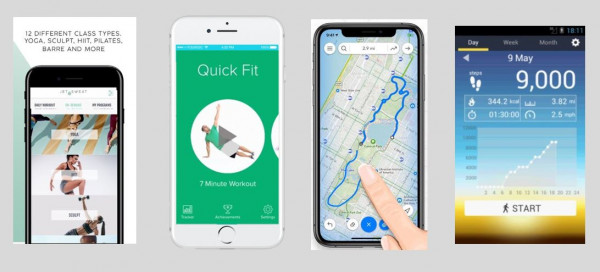Exercise apps
Also called fitness apps
Exercise apps
- There are thousands of exercise apps that cover a wide range of physical activities from walking and running to exercise classes and apps for personal trainers.
- Choosing the right exercise app depends on several factors that align with your personal fitness goals, preferences, and lifestyle.

There are thousands of exercise apps that cover a wide range of physical activities from walking and running to exercise classes and apps for personal trainers. Increasingly many fitness apps can sync with a wearable device such as fitness bands and smart watches. Choosing the right exercise app depends on several factors that align with your personal fitness goals, preferences, and lifestyle. See below, Deciding on suitable apps - help me choose.
Types of exercise apps
Physical activity apps can be categorised into five groups according to their main focus:1
- workout apps that demonstrate various exercises
- tracking of movement apps that map running, walking or cycling routes
- running programmes that have pre-specified goals reached by gradual small increases in run-to-walk ratio
- pedometer-based apps that count steps
- interval timers that time work and rest periods.

Can smartphone apps increase physical activity?
To answer that question, we need to look at the evidence provided by reliable studies, such as randomised controlled trials. An analysis of 9 such trials that used a smartphone app as the key intervention to increase physical activity found that these apps had a modest positive influence on physical activity.2 Physical activity was measured as either moderate-to-vigorous physical activity minutes or steps. The analysis found that, in particular, smartphone apps have a significant positive effect on physical activity when used over a short-term period (ie, less than 3 months) and where apps target physical activity alone, rather than physical activity in combination with other health behaviors. The authors conclude that future research is needed to understand more about the effect of the apps over time, and to investigate strategies to sustain the effects of using the apps over time.
Deciding on suitable apps - help me choose
 As there are so many apps for physical activity and exercise, finding a fitness app to meet your needs can be challenging. It depends largely on your preferred type of exercise and other qualities you want your app to have. The inclusion of behaviour change techniques in the app features may be helpful. For example, does the app have the following features:3
As there are so many apps for physical activity and exercise, finding a fitness app to meet your needs can be challenging. It depends largely on your preferred type of exercise and other qualities you want your app to have. The inclusion of behaviour change techniques in the app features may be helpful. For example, does the app have the following features:3
- goal setting: prompt you to set goals and plan your exercises
- monitoring: allow you to monitor your progress
- feedback: provide feedback on your performance
- rewards: offer rewards when you achieve your goal
- social support: have an online community or other means of social support.
Alternatively, when deciding on a fitness app, you may find the use of the fitness app scoring instrument [PDF, 172 KB] useful to compare and contrast features.4
- This tool is based on the American College of Sports Medicine (ACSM) recommended exercise prescription, which consists of three main components: aerobic exercise, strength and resistance, and flexibility.
- It provides a structured way of assessing fitness apps and has notes or qualifiers to help you along.
Helpful websites and resources
We have not been able to review all the fitness and exercise apps available in the app stores. We have instead identified independent organisations that have reviewed these apps and other resources that may be helpful.
| Resource | Target audience | Description |
|
Healthy living apps(external link) (VicHealth, Australia) |
Adults | This website has reviewed more than 250 physical activity and sport apps. To find an app that suits you, you can search for apps by device, age group and pricing. |
|
Health & Fitness app reviews(external link) (Common Sense Media, US) |
Children | This website has reviews of health and fitness apps for children. |
| Older adults | This website has: |
Resources
Fitness app scoring instrument [PDF, 172 KB] Assessing the Quality of Mobile Exercise Apps Based on the American College of Sports Medicine Guidelines, 2017
Physical activity benefits for adults and older adults(external link) GOV UK, 2011
References
- Bondaronek P, Alkhaldi G, Slee A, et al. Quality of Publicly Available Physical Activity Apps: Review and Content Analysis.(external link) JMIR Mhealth Uhealth. 2018 Mar 21;6(3):e53.
- Romeo A, Edney S, Plotnikoff R, et al. Can Smartphone Apps Increase Physical Activity? Systematic Review and Meta-Analysis(external link). J Med Internet Res. 2019 Mar 19;21(3)
- Wang Q, Egelandsdal B, Amdam GV, et al. Diet and Physical Activity Apps: Perceived Effectiveness by App Users(external link). JMIR Mhealth Uhealth. 2016 Apr 7;4(2):e33.
- Kebede M, Steenbock B, Helmer SM, et al. Identifying Evidence-Informed Physical Activity Apps: Content Analysis.(external link) JMIR Mhealth Uhealth. 2018 Dec 18;6(12).
- Guo Y, Bian J, Leavitt T, et al. Assessing the Quality of Mobile Exercise Apps Based on the American College of Sports Medicine Guidelines: A Reliable and Valid Scoring Instrument.(external link) J Med Internet Res. 2017 Mar 7;19(3):e67.
|
Disclaimer: The NZ Health App Library is a free consumer service to help you decide whether a health app would be suitable for you. Our review process is independent. We have no relationship with the app developers or companies and no responsibility for the service they provide. This means that if you have an issue with one of the apps we have reviewed, you will need to contact the app developer or company directly. |
Factsheets – using health apps safely

How to choose a health app
Healthify He Puna Waiora, NZ

Privacy and security tips for using health apps
Healthify He Puna Waiora, NZ
Last reviewed:
Page last updated:


